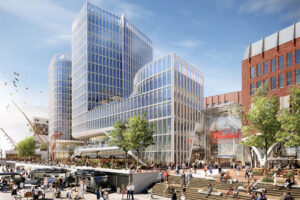BY JONATHAN DOUGHTY
This year is no different, but for the retail property industry, there is a change in attitude and focus also taking place with foodservice. Mapic was highly successful for our business, not just because Cannes is a great meeting point, but also because food and drink are now firmly at the heart of thinking surrounding new projects.
We were lucky enough to have several projects opening just before Mapic that created more than enough “noise” for us, along with our JLL “Food in Fashion” cocktail party, but the really important change is in the way that the industry is now looking at the spread of foodservice, the operators, and their franchisee and operating partners.
I have written in this column before about the changes that need to happen to see foodservice operating companies and brands spread across Europe and further into new markets, the need for those operators to find quality partners and for developers and landlords to change their approach and communication with foodservice operators. Having spent time with a number of clients recently on just this subject, I thought it might be helpful to outline exactly what I mean, hence the title “the new language of leasing” with reference to foodservice.
First of all, most foodservice operators do not really understand property and what makes it “tick.” The most successful chains and operating companies have great property teams, but this is not uniform throughout the whole industry and, as we see a change from “international” brands to more local and regional operators, this is going to become a big problem. The companies and businesses that we want to attract as part of the foodservice mix of a development are different, quirky, regional, focused and highly unlikely to even understand the “language” of the property industry. Words like “GLA,” “net area,” “upwards only,” “turnover clauses,” “service charge,” and “effort rate” are largely alien to the way they have historically done their business. So let’s see if I can help with the translation from “property world” to “foodservice world” in the next few paragraphs in order to make this transition easier.
Guest not customer
This is a fundamental and really important point. Most foodservice operators are about experience and not transaction, so by using language that they understand, focusing on their “guest” and what they want, you are far more likely to get their interest. If you attract the same people as their guest, they can see where the business will come from.
Experience not transaction
As I mentioned in the first point, foodservice operators are much more interested in understanding how their offer and proposition can fit into the “bigger picture.” They provide experiences, so they need other supporting things around them like other foodservice, great environments, leisure locations, and well-designed areas. These need to be explained along with their benefits.
Average spend not net sales
The dynamics of the restaurant business are very different to retail and we believe that a focus on the average spend that an operator will take, not just the net sales per week, month or year, will help them understand what is the potential level of business. Having supporting information that allows operators to work that out is helpful. For example, a site that can sell alcohol and provides a good night-time ambience is going to have a very different average spend to one that is daytime and “functional” only. When planning a development, you need to set the operating parameters so that potential tenants can understand the rules.
Seats not GLA
For most foodservice operators, the number of seats they can provide, and how many times they can turn them over in a meal session, is far more important than the GLA that they have. Sure, the size has to be right, but creating great seating areas and providing the guest with a choice is vital to commercial success. Telling an operator you want it to take 300 sq m doesn’t really help it appreciate what is on offer or what shape it is. Please stop building shops and then trying to rent them as restaurants.
Cost to occupy not rent
One of the biggest differences is the multiple layers of costs that go with taking foodservice units in shopping centers. Base rents, turnover rents, service charges, food court charges, rates, and marketing costs all come together to create a scary number for many of these operators. By simplifying the explanation and the “packaging” of this with them, you are far more likely to succeed. This is more than just working out the “effort rate,” it is making sure they understand and feel comfortable with the property cost in the same way they do with labor costs. This is often a percentage of sales that they feel comfortable with and understand.
Support not rules
Running foodservice businesses within the shopping environment is tough, for many reasons. In most cases, there are numerous rules that have to be adhered to, mostly designed around the larger retail tenants, which center on deliveries, refuse, staff, and other important inputs to a business. By making these specific and appropriate to foodservice businesses, they will be seen as more supportive rather than rules that have to be obeyed. A great example is the service yard that doesn’t allow early morning deliveries, requiring the three quality restaurants in the scheme to take their daily food deliveries later, when they should already be preparing the food. Inconvenient, yes, and very counter-productive.
Opportunity not cost
I have saved the most important one for last. If you go to talk to a foodservice operator and you say “we want you to take this unit, of this size, and this rent” I would be surprised, if they are regional or local, if they took the discussion further. There is no “place setting” or story. If, on the other hand, the business opportunity is explained to them, along with whom they will sit next to, what the overall project is about, how many people, and how much they will spend, the operator can then firmly imagine themselves in the unit. Of course, the developers and landlords not only need to work out that story, they also need to test it against their rental reality and make sure the message and marketing is consistent.
Our clients know there is a difference and we actively promote the fact that foodservice operators need to know more, earlier, to be able to make informed decisions about where they are going to take space. From a developer and landlord perspective, it is so much easier to rent space to the same people in every project, but that, I’m afraid, simply isn’t going to cut it in the future. Foodservice is going more regional and local, there is strong evidence of an emotional attachment to it, and the international and national mega-brands do not create that emotional response to the same degree. “Mixing it up” is the order of the day and the language you use to talk with the foodservice community will help hugely in getting them on board and performing for your guests. It’s all in the detail.
What is your opinion on this topic? Discuss it with us! Send your opinion to opinion@across-magazine.com !






![Titel_Across_1_24_Endversion[111270] Titel_Across_1_24_Endversion[111270]](https://www.across-magazine.com/wp-content/uploads/elementor/thumbs/Titel_Across_1_24_Endversion111270-qjpg2yp7x6msxzo90wpo62uop32tmjtjils84ezryg.jpg)
